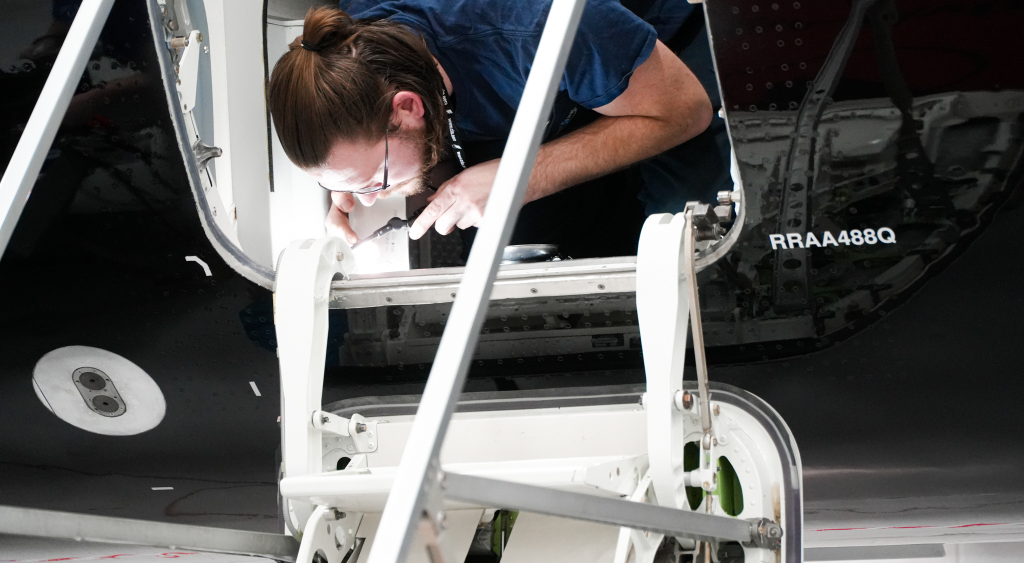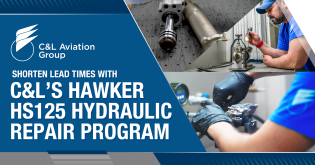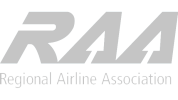You wouldn’t buy a used car without taking a look under the hood, so why wouldn’t you have a used aircraft inspected before making the purchase? With a pre-purchase inspection for a private aircraft, you’ll gain insight – from understanding the history of the aircraft to identifying any possible airworthiness issues.
We have performed hundreds of pre-purchase inspections and know that inspections best serve the buyer when tailored to the type of aircraft and the buyer’s needs. In this article, we provide information about the available inspection options and why it is a good idea to have an aircraft inspected before buying it.

What Happens During a Pre-Purchase Inspection?
What is a Pre-Purchase Inspection?
A pre-purchase inspection (PPI), or pre-buy inspection, is the inspection a potential buyer has performed on an aircraft they are considering buying. The inspection is usually provided by an MRO.
What is the Pre-Purchase Inspection Process?
Both the buyer and seller negotiate which MRO can perform the inspection and what level of inspection can be done on the aircraft. The MRO should represent the interests of the potential buyer and should not be affiliated with the seller.
Once the inspection is complete, the MRO submits a report detailing any issues to both the buyer and seller. The buyer and seller will negotiate again, deciding what repairs need to be made and who will pay for them. In most cases, the seller will cover airworthiness-related expenses, while cosmetic costs fall to the buyer after purchasing the aircraft.
The potential buyer will pay for the inspection, regardless of whether the aircraft is purchased.
How Long Will the Pre-Purchase Inspection Take?
The size of the aircraft and how deep the inspection goes will determine the length of downtime for the inspection. The pre-buy inspection process can take as little as a few weeks to as long as a few months.
Kinds of Inspection that can be Performed
What is covered in a pre-purchase inspection will vary depending on the needs of the potential buyer (and what the seller will approve), the make and model of the aircraft, and what the MRO providing the inspection can perform at their facility.
Typically, the inspection will either be an A or B check. Additionally, the buyer will want the aircraft records reviewed. A borescope inspection of the aircraft engines should be done – unless the engines are on an OEM engine program and the OEM does not require a borescope inspection to remain on the program.
As long as both the buyer and seller agree on what the inspection entails, the MRO can begin their review. The MRO may also have suggestions on what should be checked out, based on their previous experience with that particular aircraft.
Documentation
Every aircraft should be accompanied by extensive documentation, records, and a logbook, outlining the aircraft’s complete history from “birth.” These documents specify part traceability and all maintenance – scheduled or unplanned – that has been completed on the aircraft. If the aircraft was ever involved in an incident that required a major repair or modification, it would be included in the aircraft records.
Aircraft Inspection Services
There is no requirement for what to review during a pre-purchase inspection. If you are not sure what areas are the most crucial to inspect, your MRO should be able to assist you. It is generally a good idea to have the following services performed, regardless of the type of aircraft:
- Fluids leak checks
- Fuel leak checks
- Window and windshield check
The following are some additional services you may want during a pre-buy inspection:
- Corrosion inspection
- General inspection (dents, scratches, nicks, missing rivets, missing sealant, etc.)
- Engine checks (including APU if applicable)
- Ground power runs
- Borescope services
- Avionics and electrical systems check
- Flight deck avionics and instruments
- Entertainment systems
- Interior inspection
- Seat function and conditions inspection (both in the cockpit and cabin)
- Lavatory
- Interior soft goods (general condition of materials)
- Cabinetry function and condition inspection
- Paint inspection

Common Issues Found During Pre-Purchase Inspection
A pre-purchase inspection won’t always turn up major issues with the aircraft, but what does turn up during an inspection may be a deciding factor in whether or not you go through with the purchase. The following is a list of issues that commonly turn up during a pre-purchase inspection:
- Improperly documented, certified, or approved upgrades/modifications
- Missing documentation
- Repairs made outside of routine inspections
- Inoperative or obsolete avionics and electronic systems (cockpit/flight deck avionics, CMS, IFE, wi-fi connectivity, etc.)
- Leaks
- Windshield and/or window damage
- Engine issues
- Corrosion
- Hidden damage from a major incident
Should You Have a Pre-Purchase Inspection?
Pre-purchase inspections may reveal issues with the aircraft that may be expensive to rectify. Yet, some buyers may not think a pre-purchase inspection is necessary due to the cost of inspection or misconceptions they may hold.
Inspection Expenses
Some potential buyers are hesitant to have a pre-purchase inspection because of the cost. Why would a person invest a considerable amount of money into an aircraft that they may not buy? A pre-purchase inspection may offer some peace of mind and could potentially save you money in the long run. If issues with the aircraft are discovered after it has been purchased, the cost to rectify these issues will fall to the new owner – even if the issues are airworthiness-related which should have been covered by the previous owner before selling the aircraft.
Commonly-Held Misconceptions
Pre-purchase inspections are always recommended – no matter the situation under which the aircraft is being sold. Misconceptions about purchasing aircraft may result in buyers choosing to not have a pre-purchase inspection. These misconceptions usually include:
- If the aircraft recently had a major inspection
- If the aircraft is only a few years old (in seemingly mint condition)
- If the aircraft is being sold by a reputable source.
Note: How thorough the inspection needs to be is influenced by what work has recently been done on the aircraft, the age of the aircraft, or who is selling the aircraft. For instance, if the aircraft recently received a major inspection – such as the highest level of maintenance – a minimal inspection may be all that is needed.

Tips to Keep in Mind During Pre-Purchase Inspection
It is always a good idea to have a pre-purchase inspection done on the aircraft you are considering buying. Many times, any airworthiness issues discovered during the inspection process, which are the responsibility of the seller, will cover the cost of the pre-purchase inspection for the buyer.
- Have the pre-buy inspection performed on the aircraft by a third party (someone who is not associated with the sale of the aircraft).
- Choose an MRO that specializes in the aircraft you want to buy. They will likely know where the problem areas are and what to look for on that aircraft.
- Learn the aircraft’s history – when and where the aircraft was used (or not), part traceability, etc.
- Review airworthiness directives (AD).
- Review service bulletins (SB).
- If you buy the aircraft while it is still at the MRO after the inspection (and any maintenance), you may choose to have cosmetic work and upgrades made to the aircraft to minimize downtime (note: the purchase must be complete before upgrades and other maintenance can be performed on the aircraft).

















